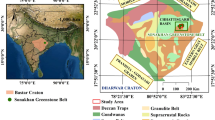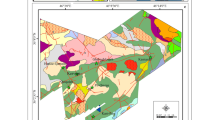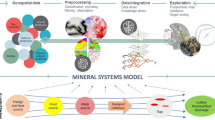Guidelines for mineral exploration normally are based on models for a given type of ore deposit. These guidelines usually are based on descriptive and metallogenetic data, and on expertise judgment. This paper presents a comparison between results produced by two of these methods: weights-of-evidence and fuzzy logic. The mineral favorability maps for gold exploration were produced in a Geographic Information Systems (GIS) environment and took into account five sources of data and information: (i) satellite images; (ii) a geochemical survey; (iii) an airborne geophysical survey; (iv) geo-structural mapping; and (v) ground elevation. These data and information were integrated through a conceptual model developed for gold mines and occurrences in the studied region. Both favorability maps highlighted the known gold occurrences and validated the approach. High gold potential areas highlighted by both maps show good correlation. But, the weights-of-evidence method delineated smaller highly favorable areas compared to the fuzzy logic map. On the other hand, the weights-of-evidence method produced higher biased probability within the favorable zones when compared with fuzzy logic methods favorable areas. New exploration targets were identified and should be further investigated.











Similar content being viewed by others
References
Agterberg, F. P., 1989, Computer programs for mineral exploration: Science, v. 245, no. 4913, p. 76–81.
Agterberg, F. P., 1992, Combining indicator patterns in weights of evidence modeling for resource evaluation: Nonrenewable Resources, v. 1, no. 1, p. 39–50.
Agterberg, F. P., and Bonham-Carter, G. F., 1990, Deriving weights of evidence from geoscience contour maps for the prediction of discrete events, in Proc. 22 nd Intern. Symp. APCOM, (Berlin): Technical Univ., Berlin, v. 2, p. 381–396.
Agterberg, F. P., and Bonham-Carter, G. F., 1999, Logistic regression and weights of evidence modeling in mineral exploration, in Computer Applications in the Mineral Industries: Proc. 28th Intern. Symposium APCOM'99, Colorado, USA, p. 583–590.
Amaro, V. E., and Strieder, A. J., 1994, Análise de fotolineamentos e de padrões estruturais em imagens de satélite, in 38 Congresso Brasileiro de Geologia, Bal. Camboriú, SC., Brasil, Bol. Res. Exp., v. 1, p. 443–444.
An, P., Moon, W. M., and Rencz, A., 1991, Application of fuzzy set theory for integration of geological, geophysical and remote sensing data: Can. Jour. Exploration Geophysics, v. 27, no. 1, p. 1–11.
Bonham-Carter, G. F., 1991, Integration of geoscientific data using GIS, in Maguire, J. D., Goodchild, M. F., Rhind, D. W., eds., Geographical Information Systems: principles and applications: Longman, London, v. 1, p. 171–188.
Bonham-Carter, G. F., 1994, Geographic Information Systems for geoscientists: Modeling with GIS: Pergamon, Ontario, Canada, p. 398.
Bonham-Carter, G. F., Agterberg, F. P., and Wright, D. F., 1988, Integration of geological datasets for gold exploration in Nova Scotia: Photogrammetric Eng. and Remote Sensing, v. 54, no. 11, p. 1585–1592.
Bonham-Carter, G. F., Agterberg, F. P., and Wright, D. F., 1989, Weights of evidence modelling: A new approach to mapping mineral potential, in Agterberg, F. P., and Bonham-Carter, G. F. eds., Statistical Applications in the Earth Sciences: Geol. Survey Canada Paper 89–9, p. 171–183.
Crosta, A. P., and Moore, J. McM., 1989, Enhancement of landsat thematic mapper imagery for residual soil mapping in SW Minas Gerais State, Brazil: a prospecting case history in greenstone belt terrain, in Proc. 7th (ERIM) Thematic Conference: Remote Sensing for Exploration Geology (Calgary), p. 1173–1187.
Eastman, J. R., 1997, Idrisi for Windows User's Guide, Version 2.0: Clark University, MA, USA.
Efimov, A. V., 1978, Multiplikativniyj pokazatel dlja vydelenija endogennych rud aerogammaspectrometriceskim dannym, in Metody rudnoj geofiziki. Lenigrad, Naucnoproizvodstvennoje objedinenie Geofizica Ed., p. 59–68.
Fang, J. H., 1997, Fuzzy logic & geology: Geotimes, October, v. 42, no. 10, p. 23–26.
Glikson, A. Y., 1997, Mineral-mapping in the north Pilbara Craton. A directed principal components of the band ratios method for correlating Landsat-5 Thematic Mapper spectral data with geology: AGSO-Australian Geol. Survey Organisation Research Newsletter, v. 26, p. 1–4.
Gnojek, I., and Prichystal, A., 1985, A new zinc mineralization detected by airborne gamma-ray.
Groves, D. I., Barley, M. E., Barnicoat, A. C., Cassidy, K. F., Fare, R. J., Hageman, S. G., Ho, S. E., Hronsky, J. M., Mikucki, E. J., Mueller, A. J., McNaughton, N. J., Perring, C. S., Ridley, J. R., and Veancombe, J. R., 1992, Sub-greenschist to granulite-hosted Archaean lode-gold deposits of the Yilgarn Craton: a depositional continuum from deep-sourced hydrothermal fluids in a crustal-scale plumbing systems: Geology Depart. (Key Centre) and University Extension, Univ. Western Australia Publ., v. 22, p. 366–374.
Harris, D. P., and Pan, G., 1991, Consistent geological areas for epithermal gold-silver deposits in the Walker Lake Quadrangle of Nevada and California delineated by quantitative methods: Econ. Geology, v. 86, no. 1, p. 142–165.
Harris, D., and Pan, G., 1999, Mineral favorability mapping: A comparison of artificial neural networks, logistic regression and discriminant analysis: Natural Resources Research, v. 8, no. 2, p. 93–109.
Kerrich, R., 1993, Perspectives on genetic models for lode gold deposits: Mineralium Deposit, v. 28, p. 362–365.
Lindgren, W., 1933, Mineral deposits (4th edn.): McGraw-Hill Book Co., New York, p. 930
Loughlin, W. P., 1991, Principal component analysis for alteration mapping: Photogrammetric Engineering & Remote Sensing: v. 57, no. 9, p. 1163–1169.
Mikucki, E. J., and Ridley, J. R., 1993, The hydrothermal fluid of Archaean lode-gold deposits at different metamorphic grades: Compositional constraints from ore and wallrock alteration assemblages: Mineral Deposits, v. 28, no. 6, p. 469–481.
Pan, G. C., 1993, Canonical favorability model for data integration and mineral potential mapping: Computers & Geoscience, v. 19, no. 8, p. 1077–1100.
Pan, G. C., 1996, Extended weights of evidence modeling for the pseudo-estimation of metal grades: Nonrenewable Resources, v. 5, no. 1, p. 53–76.
Pires, A. C. B., 1995, Identificação Geofisica de Áreas de Alteração Hidrotermal, Crixás-Guarinos, Góias: Revista Brasileira de Geociências, v. 25, no. 1, p. 61–68.
Quadros, T. F. P., De, 1995, Geologia e gênese do depósito aurífero da Mina San Gregorio, Dissertação de Mestrado, Curso de Pós-graduação em Geociências, Universidade Federal do Rio Grande do Sul, p. 196.
Quadros, T. F. P., Koppe, J. C., and Strieder, A. J., 1995, Dynamic shear development and mineralization at the San Gregorio Gold Mine, Uruguay, in Rossmanith, H. P., ed., Proc. II Intern. Conf. on Mechanics of Jointed and Faulted Rocks (Viena, Austria): A. A. Balkema Publ., Rotterdam (Netherlands), p. 347–353.
Quadros, T. F. P. De, Koppe, J. C., and Strieder, A. J., 1997, Lineament analysis for gold deposit exploration in the Rivera Shear System: World Gold'97 Conf. (Singapore): Proc. World Gold'97 Conf.: Australasian Inst. Mining and Metalurgy, (AIMM) v. 1, p. 19–22.
Reynolds, H. T., 1997, The analysis of cross-classifications, in TYDAC Research Inc., Explorer Spans.
Saunders, D. F., Terry, S. A., and Thompsom, C. K., 1987, Test of National Uranium Resource Evaluation gamma-ray spetral data in petroleum reconnaissance: Geophysics, v. 52, no. 11, p. 1547–1556.
Singer, D. A., and Kouda, R., 1988, Integrating spatial and frequency information in the search for kuroko deposits of the Hokuroko District, Japan: Econ. Geology, v. 83, no. 1, p. 18–29.
Singer, D. A., and Kouda, R., 1996, Application of a feedforward neural network in the search for Kuroko deposits in the Hokuroko District, Japan: Math. Geology, v. 28, no. 8, p. 1017–1023.
Singer, D. A., and Kouda, R., 1999, A comparison of the weights of evidence method and probabilistic neural networks: Natural Resources Research, v. 8, no. 4, p. 281–298.
Tydac, 1997, SPANS User Guide, Version 6.0. Tydac Technologies Inc. Ottawa, Ontario, Canada.
Wright, D. F., and Bonham-Carter, G. F., 1996, VHMS favourability mapping with GIS-based integration models, Chisel Lake-Anderson Lake area, in Bonham-Carter, G. F., Galley, A. G., and Hall, G. E. M., eds., Extech I: A multidisciplinary approach to massive sulphine research in the Rusty Lake-Snow Lake Greenstone Belts, Manitoba; Geol. Survey of Canada. Bull. 426, p. 339–401.
ACKNOWLEDGMENTS
The authors would like to thank CAPES, CNPq, and the staff of the Crystallex Inc. to support this research.
Author information
Authors and Affiliations
Corresponding author
Rights and permissions
About this article
Cite this article
de Quadros, T.F.P., Koppe, J.C., Strieder, A.J. et al. Mineral-Potential Mapping: A Comparison of Weights-of-Evidence and Fuzzy Methods. Nat Resour Res 15, 49–65 (2006). https://doi.org/10.1007/s11053-006-9010-9
Received:
Accepted:
Published:
Issue Date:
DOI: https://doi.org/10.1007/s11053-006-9010-9




